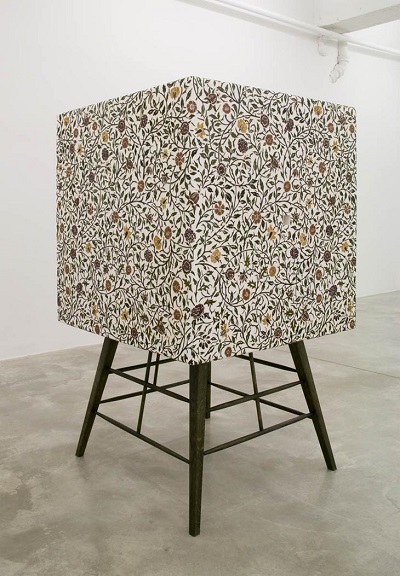
David Thorpe
British, 1972-
Quiet Lives, 2010
Plaster, leather, light system, wood stand
42 1/4 x 41 3/4 x 41 3/4"
Courtesy of the artist and Casey Kaplan, NY
COMMENTS
David Thorpe’s work is concerned with the relationship between objects and their makers, with a particular interest in the role of craft and labour in handmade design and art. “I'm playing with certain associations,” he has said, “slightly New Age, slightly Space Age, slightly threatening…I'm absolutely in love with people who build up their own systems of belief.” This idea is reflected in works that variously reference modernist principles of object-making, utopian social architecture, Japanese woodblock prints, and Victorian paper-cutting.
The works shown here all make reference to an interconnectedness between ideology and lifestyle. Private Lives (2010) alludes to the aesthetics and theories of the Arts and Crafts Movement of the late 19th century and the democratising art ideals of William Morris and John Ruskin. Thorpe’s large pattern-covered objects have been executed with the collaborative assistance of skilled artisans trained in recreating labour-intensive medieval recipes for making paint and ceramic moulds.
- " David Thorpe," Saatchi Gallery, Web, 2013
SBMA CURATORIAL LABELS
BORN 1972, LONDON
LIVES AND WORKS IN BERLIN
David Thorpe is dedicated to the pursuit of an alternative reality in which the past, present, and future lie in delicate balance. While his work has taken many forms, his process has long been invested in the handcrafted.
Much of Thorpe’s work reinterprets artisanal traditions for the 21st century. In The Impenetrable Friend, the artist merges medieval European stained glass with minimalist forms. His watercolor drawing End Pattern is a revival of the 18th and 19th-century tradition of botanical illustration, but fragmented in a manner that suggests mutation.
This vegetal motif is also expressed in Quiet Lives, a plaster cube constructed by Thorpe and a team of artisans. The cube is ornately inlaid with leather pieces that form an interlocking stem-and-leaf pattern akin to a wallpaper or textile design by William Morris. In a similar fashion, The Plague resembles Morris’s highly prized handmade carpets, but here, made of painted tiles. While these works reference beauty in nature and design, their titles suggest something more ominous.
Labour and Wait, 2013
